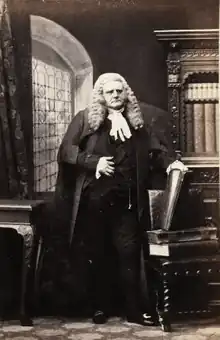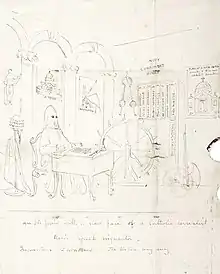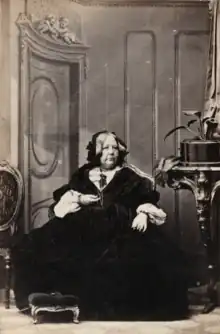Henry Bagshawe
Henry Ridgard Bagshawe (1799–1870) was an English barrister and judge.[1] A Roman Catholic convert of 1834, he served as a managing editor of the Dublin Review from 1837 to 1863.
Henry Ridgard Bagshawe M.A., Q.C. | |
|---|---|
 Henry Bagshawe, 1863 photograph | |
| Born | 1799 |
| Died | 1870 (aged 70–71) |
| Occupation(s) | barrister, judge |
Life
He was born at Brigg, the second son of nineteen children (fourteen of whom survived to adulthood) of Sir William Chambers Bagshawe, a physician, and his wife Helen, daughter of Nathaniel Ridgard, of Gainsborough, Lincolnshire. His father was originally surnamed "Darling", but inherited the Bagshawe family's landed property from a distant cousin- and assumed that name- because his maternal grandmother was of that family and the male line had died out.[2] His elder brother William John, who inherited The Oakes, Sheffield, died in 1851.[1][3] Bagshawe was educated at Oakham School, and at Richmond School under James Tate. He matriculated at Trinity College, Cambridge in 1817, graduating B.A. in 1821, M.A. in 1824.[1]
In 1824 Bagshawe entered the Middle Temple, and he was called to the bar there the following year. He took silk in 1854.[1] He built up a substantial chancery practice. In 1857 he took on Charles Russell as pupil.[4]

Bagshawe was received into the Roman Catholic Church at St Patrick's Church, Soho Square in 1834, by the Rev. Edward Norris.[1][5] When Nicholas Wiseman was in London at the Sardinian Chapel in 1835–6, he stayed with Bagshawe.[6]
In 1846, Bagshawe appeared before the Commissioners in Lunacy, on behalf of Helen Gladstone (1814–1880), younger sister of William Ewart Gladstone. He and his wife were close personal friends of Helen, a Catholic convert who had been taking opium, and confined in a Carlton Gardens house owned by her father Sir John Gladstone, 1st Baronet. Bagshawe's initial request, for an application to visit to be passed to the Lord Chancellor, was accepted by Lord Ashley. Shortly, however, Thomas Gladstone and his brother William contested the claims made that Helen was under some form of restraint.[7] The application via the Commissioners did not proceed; but Helen left the house to stay with Catholic friends in Bath about a week later.[8]
In 1861 Bagshawe was made a county court judge in west Wales (Cardigan, Carmarthen and Pembroke).[1] In the wake of the Prison Ministers Act 1863 he was active in supporting the visiting rights of Catholic priests in Glamorgan jails in particular.[9] There was substantial immigration to Glamorgan and Cardiff in the first half of the 19th century, from south-east Ireland and elsewhere.[10] In 1861 his son had made an issue of religious education access to workhouses.[11] In 1864 Bagshawe argued against a decision of the Board of Guardians in Swansea, where his wife and family had been making workhouse visits, to restrict entry to accredited ministers of religion; he obtained an amendment.[12] Gilley comments on a family reputation for proselytism, as possibly counter-productive.[9]
In 1868 Henry Bagshawe was also made a judge for the Clerkenwell District in London. He died at 21 Fellows Road in north-west London on 16 May 1870.[1]
Editor of the Dublin Review
Bagshawe's position at the Dublin Review has been described as "executive editor"[13] or "managing director".[14] He came in for issue #6 in 1837, issues #4 and #5 having been edited by James Smith (died 1866).[15][16]
In 1839 Frederick Lucas, who wrote for the Dublin Review, was brought in as co-editor with Bagshawe. The arrangement lasted until 1842, when Lucas began to take an aggressive line towards the Review in The Tablet, his own publication.[17][18] There was a hiatus in Bagshawe's editorship in the summer of 1858, while Lord Acton considered terms under which he might take over the Review.[19][20] Bagshawe took executive decisions, but editorial policy was laid down by Wiseman and Charles William Russell. William George Ward took over in 1863.[21]
Family

Bagshawe married in 1824 Catherine Elizabeth Gunning, daughter of the army surgeon John Gunning (1773–1863), and his wife Catherine Gilpin.[1][22][23] She is listed as a Catholic convert;[24] and died in 1878 at age 75.[25] Their children included:
- William Henry Gunning Bagshawe (1825–1901), barrister and judge, married 1861, Harriet Theresa Stanfield, daughter of Clarkson Stanfield. He was elevated as Q.C. in 1874.[26][27] The painter Joseph Ridgard Bagshawe was their son.[28] He was generally referred to as Henry Bagshawe, and his wife as Mrs. Henry Bagshawe, meaning confusion with his father is possible.
- John Bernard Bagshawe (1827–1901), Catholic priest.[29]
- Edward Gilpin Bagshawe (1829–1915), Catholic bishop.[30]
- Clement Walsh Bagshawe (1840–1901), fourth son, tea planter at Katlicherra, Assam, married in 1865 Elizabeth Melvill, daughter of Henry Melvill.[31]
- Frederic(k) Gladstone Bagshawe, fifth and youngest son, married 1869 Emily Teresa Bolton, daughter of Thomas Bolton of Oaken Hall, Codsall.[32][33]
- Catherine Helen, eldest daughter, died 1910 aged 83.[34]
- Jane Edith, second daughter, died 1883.[35]
- Mary Isabella, third daughter, married in 1857, at Muzaffarpur, Donald Horne Macfarlane.[36]
- Catherine Monica, fourth daughter, married in 1870 Henry Latter of Ashford.[37][38]
- Francesca Maria Sforza married in 1861, in Calcutta, the architect Christopher George Wray.[39]
Notes
- "Bagshawe, Henry Ridgard (BGSW816HR)". A Cambridge Alumni Database. University of Cambridge.
- Burke's Genealogical and Heraldic History of the Landed Gentry, 18th edition, vol. 1, ed. Peter Townend, Burke's Peerage Ltd, 1965, pp. 30-32
- "Funeral of W. J. Bagshawe, Esq". Sheffield Independent. 14 June 1851. p. 8.
- Agnew, Sinéad. "Russell, Charles Arthur, Baron Russell of Killowen (1832–1900)". Oxford Dictionary of National Biography (online ed.). Oxford University Press. doi:10.1093/ref:odnb/24301. (Subscription or UK public library membership required.)
- Ward, Bernard Nicolas (1915). The Sequel to Catholic Emancipation: The Story of English Catholics Continued Down to the Re-establishment of Their Hierarchy in 1850. Vol. I. Longmans, Green and Company. p. 67.
- Gwynn, Denis (1950). Cardinal Wiseman. Browne & Nolan. p. 40.
- Isba, Anne (24 August 2006). Gladstone and Women. A&C Black. pp. 56–58. ISBN 978-1-85285-471-3.
- Isba, Anne (2003). "Trouble with Helen: The Gladstone Family Crisis, 1846–1848". History. 88 (2 (290)): 254. doi:10.1111/1468-229X.00261. ISSN 0018-2648. JSTOR 24427041.
- Swift, Roger; Gilley, Sheridan (31 October 2013). Irish Identities in Victorian Britain. Routledge. pp. 179–180. ISBN 978-1-317-96557-2.
- O'Leary, Paul (1 January 2004). Irish Migrants in Modern Wales. Liverpool University Press. p. 35. ISBN 978-0-85323-858-4.
- Illustrated Times: Weekly Newspaper. 1861.
- "Swansea Board of Guardians: The Religious Instruction of the Inmates". Tablet. 31 December 1864. p. 11.
- Renouf, Peter Le Page (2002). The Letters of Peter Le Page Renouf (1822-1897): Pembroke College, Oxford (1840-1842). St. Mary's College, Oscott (1842-1846). University College Dublin Press. p. 220. ISBN 978-1-900621-65-6.
- MacAuley, Ambrose (1983). "Charles William Russell DD President of Maynooth 1857-80". Archivium Hibernicum. 38: 36–37. doi:10.2307/25487447. ISSN 0044-8745. JSTOR 25487447.
- Herbermann, Charles, ed. (1912). . Catholic Encyclopedia. Vol. 14. New York: Robert Appleton Company.
- Dublin Review. W. Spooner. 1896. p. 252.
- Altholz, Josef L. "Lucas, Frederick (1812–1855)". Oxford Dictionary of National Biography (online ed.). Oxford University Press. doi:10.1093/ref:odnb/17127. (Subscription or UK public library membership required.)
- Houghton, Walter E. (1972). The Wellesley Index to Victorian Periodicals: 1824 - 1900. Vol. II. University of Toronto Press. p. 19 and note 48. ISBN 978-0-8020-1926-4.
- The Correspondence of Lord Acton and Richard Simpson. Vol. I. CUP Archive. 1971. p. 48.
- The Correspondence of Lord Acton and Richard Simpson. Vol. I. CUP Archive. 1971. p. 80.
- Houghton, Walter E. (24 May 2013). The Wellesley Index to Victorian Periodicals 1824-1900. Routledge. p. 19. ISBN 978-1-135-79550-4.
- "Gunning, John (1773 - 1863)". livesonline.rcseng.ac.uk.
- Burke, Bernard (1862). A Genealogical and Heraldic Dictionary of the Landed Gentry of Great Britain and Ireland. Vol. I. London: Harrison. p. 614.
- Gorman, W. Gordon (1885). Converts to Rome: A List of about Four Thousand Protestants who Have Recently Become Roman Catholics. W. Swan Sonnenschein and Company. p. 53.
- "Deaths". Tablet. 11 May 1878. p. 16.
-
 Foster, Joseph (1885). . (second ed.). London: Hazell, Watson, and Viney.
Foster, Joseph (1885). . (second ed.). London: Hazell, Watson, and Viney. - "Bagshawe, His Honour Judge William Henry Gunning". Who's Who. A & C Black. Retrieved 26 September 2022. (Subscription or UK public library membership required.)
- van der Merwe, Pieter. "Stanfield, Clarkson (1793–1867)". Oxford Dictionary of National Biography (online ed.). Oxford University Press. doi:10.1093/ref:odnb/26234. (Subscription or UK public library membership required.)
- "The Very Rev. Canon Bagshawe D.D. November 1901". Forgotten Victorians. 31 July 2016.
- Reilly, Catherine (1 January 2000). Mid-Victorian Poetry, 1860-1879. A&C Black. p. 23. ISBN 978-0-7201-2318-0.
- "Obituary Notices". Homeward Mail from India, China and the East. 15 July 1901. p. 4.
-
 Foster, Joseph (1885). . (second ed.). London: Hazell, Watson, and Viney.
Foster, Joseph (1885). . (second ed.). London: Hazell, Watson, and Viney. - "Marriages". London City Press. 30 October 1869. p. 8.
- The Law Times. Office of The Law Times. 1910. p. 484.
- "Deaths". Tablet. 26 May 1883. p. 16.
- The Indian News and Chronicle of Eastern Affaires: 1857. 1857. p. 199.
- The Pall Mall Budget: Being a Weekly Collection of Articles Printed in the Pall Mall Gazette from Day to Day, with a Summary of News. 1870. p. 274.
- The Tablet. Tablet Publishing Company. 1870. p. 620.
- The Monthly (alphabetical) record of births, deaths, & marriages (and Alphabetical list of estates of deceased persons). p. 371.